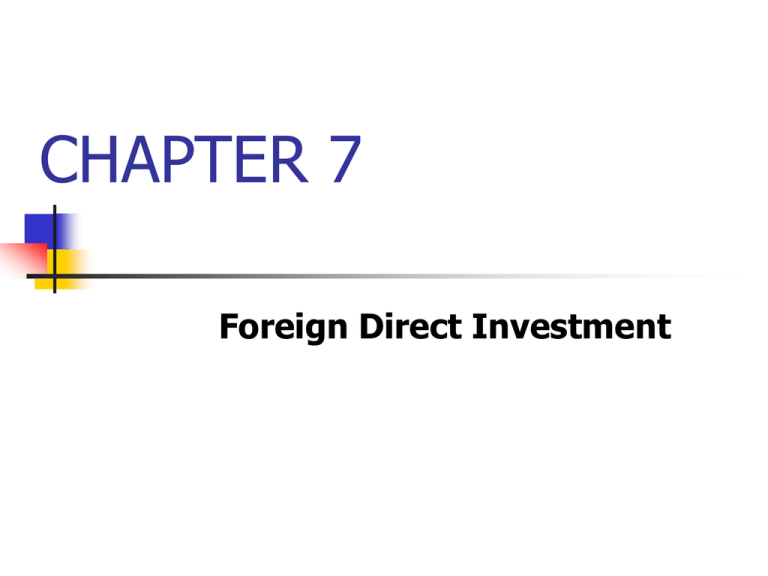
CHAPTER 7
Foreign Direct Investment
6-2
Learning Objectives
McGraw-Hill/Irwin
What are the global trends in FDI?
Why China receives a lion’s share of
total foreign investment?
What are the consequences of MNC’s
increasing presence in developing
countries?
© 2003 The McGraw-Hill Companies, Inc., All Rights Reserved.
2
6-3
Chapter Focus
McGraw-Hill/Irwin
This chapter seeks to identify the
economic rationale that underlies
Foreign Direct Investment. For
example, why do some firms prefer FDI
to exporting or licensing. Is the need
for control, part of the answer?
© 2003 The McGraw-Hill Companies, Inc., All Rights Reserved.
3
6-4
Foreign Direct Investment
FDI occurs when a firm invests directly in facilities to
produce and/or market a product in a foreign country.
Once a firm undertakes FDI, it becomes a multinational
enterprise (multinational = more than one country).
FDI takes two forms:
Greed-field investment: establishing a wholly new
operation in a foreign country.
Acquiring or merging with an existing firm in the
foreign country.
Investing in foreign financial instruments (Portfolio
Investment) IS NOT FDI.
McGraw-Hill/Irwin
© 2003 The McGraw-Hill Companies, Inc., All Rights Reserved.
4
6-5
FDI Outflows
1982-2000
1400
1200
1000
800
600
$ Billions
400
200
0
8286
McGraw-Hill/Irwin
92
94
96
98
2000
Figure 6.1
© 2003 The McGraw-Hill Companies, Inc., All Rights Reserved.
6-6
FDI Flows by Region
600
500
Value Exports
300
World GDP
200
World FDI
Index
400
100
McGraw-Hill/Irwin
20
00
98
96
94
92
90
0
Figure 6.2
© 2003 The McGraw-Hill Companies, Inc., All Rights Reserved.
6-7
Reasons for FDI Growth
FDI circumvents potential future trade
barriers.
Dramatic political and economic
changes occurring in developing
countries.
McGraw-Hill/Irwin
© 2003 The McGraw-Hill Companies, Inc., All Rights Reserved.
7
6-8
FDI into Developed and Developing
Nations: 1990-2000
1200
$Billion
1000
Dev Nations
Devg. Nations
800
W. Europe
600
N. Amer.
400
Asia
200
L. Amer.
0
94
McGraw-Hill/Irwin
95
96
97
98
99
2000
Figure 6.3
© 2003 The McGraw-Hill Companies, Inc., All Rights Reserved.
6-9
Inward FDI Flows as a Percentage of
Gross Fixed Capital Formation, 1998
Asia
L. Amer.
N. Amer.
W. Europe
Devg. Nations
Dev. Nations
World
0
McGraw-Hill/Irwin
10
20
30
Figure 6.4
© 2003 The McGraw-Hill Companies, Inc., All Rights Reserved.
6-10
FDI Outflows by
Selected Countries, 1994-1999
300
250
200
150
1994 1995 1996 1997 1998 1999 2000
McGraw-Hill/Irwin
U.S.
U.K.
Netherlands
Germany
100
Japan
50
Spain
0
France
Figure 6.5
© 2003 The McGraw-Hill Companies, Inc., All Rights Reserved.
6-11
The Form of FDI: Acquisitions versus
Greed-Fields
McGraw-Hill/Irwin
The majority of
investments is in the
form of mergers &
acquisitions:
Represents about
77% of all flows in
developed countries.
Represent about
33% of all flows in
developing countries.
Fewer target
firms.
Why the preference for
mergers & acquisitions?
Quicker to execute.
Foreign firms have
valuable strategic
assets.
Believe they can
increase the
efficiency of the
acquired firm.
© 2003 The McGraw-Hill Companies, Inc., All Rights Reserved.
11
6-12
FDI and Risk
FDI is expensive and risky compared to exporting or
licensing:
Costs of establishing facilities.
Problems with doing business in a different
Culture.
Horizontal Direct Investment: FDI in the same industry as the
firm operates at home.
Factors to consider:
Transportation Costs.
Market Imperfections.
Following Competitors.
Strategic Competitors
Location Advantages.
McGraw-Hill/Irwin
© 2003 The McGraw-Hill Companies, Inc., All Rights Reserved.
12
6-13
Horizontal FDI and Factor Considerations
Transportation Costs: High/low value to weight impacts
costs.
Market Imperfections (Internalization Theory): Factors
that inhibit markets from working perfectly. This
includes (1) governments impeding the free flow of
products between nations, and (2) impediments to
the sale of know-how.
Strategic Behavior: Concentrated industries (oligopoly) tend
to mimic each other’s moves. Where there is
multipoint competition, competing firms match each
other’s moves to keep the competitor in check.
McGraw-Hill/Irwin
© 2003 The McGraw-Hill Companies, Inc., All Rights Reserved.
13
6-14
Horizontal FDI and Factor Considerations
The Product Life Cycle: Suggests that foreign market
demand leads to FDI, probably not true and
therefore is not a good predictor of FDI.
Location-Specific Advantages: Advantages that arise
from using resource endowments or assets tied
to a particular location (Dunning - eclectic paradigm)
McGraw-Hill/Irwin
© 2003 The McGraw-Hill Companies, Inc., All Rights Reserved.
14
6-15
Vertical FDI
Two forms:
Backward: Providing inputs (raw materials,
parts) for a firm’s domestic production
processes.
Forward: An industry abroad sells the outputs
of the firm’s domestic production processes.
McGraw-Hill/Irwin
© 2003 The McGraw-Hill Companies, Inc., All Rights Reserved.
15
6-16
Why Do Companies Engage in
FDI?
Strategic Behavior: Can raise entry
barriers or shut out new competitors, or
circumvent barriers established by
companies already doing business in the
foreign country.
Market Imperfections: Need to
overcome lack of know-how or the firm
must invest in specialized assets whose
value depends on inputs provided by a
foreign supplier.
McGraw-Hill/Irwin
© 2003 The McGraw-Hill Companies, Inc., All Rights Reserved.
16
6-17
Impediments to the Sale of Know-how
Risk giving away
know-how to
competitors
Impediments to
the sale of know
how
Licensing implies
low control over
foreign entity
Know-how not
amenable to
licensing
McGraw-Hill/Irwin
© 2003 The McGraw-Hill Companies, Inc., All Rights Reserved.
17
6-18
A Decision Framework
How high are
transportation costs
and tariffs?
High
Is know-how amenable
to licensing?
Yes
Is tight control over
foreign operation
required?
No
Can know-how be protected
by licensing contract?
Low
No
Yes
No
Export
Horizontal FDI
Horizontal FDI
Horizontal FDI
Yes
Then license
McGraw-Hill/Irwin
Figure 6.6
© 2003 The McGraw-Hill Companies, Inc., All Rights Reserved.
18





